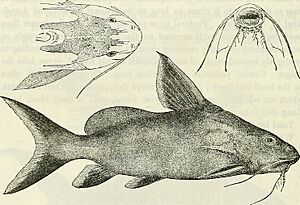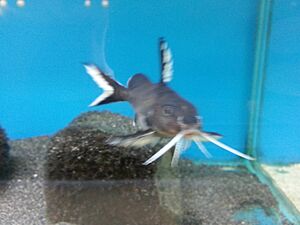Synodontis granulosus facts for kids
Quick facts for kids Synodontis granulosus |
|
|---|---|
 |
|
| Conservation status | |
| Scientific classification | |
| Synonyms | |
|
Synodontis granulosa (feminine form) |
Synodontis granulosus is a special kind of upside-down catfish. It lives only in Lake Tanganyika in Africa. This lake is shared by four countries: the Democratic Republic of the Congo, Burundi, Zambia, and Tanzania. A scientist named George Albert Boulenger first described this fish in 1900. Its name, granulosus, comes from a Latin word meaning "grainy." This is because the fish has tiny, grain-like bumps on its skin.
Contents
What Does This Fish Look Like?
Body and Head
Like other Synodontis fish, S. granulosus has a strong, bony head. This head part goes all the way back to its first dorsal fin spine. The head is about three-tenths (3/10) of the fish's total length.
The head has a unique bony bump called a humeral process. This bump's shape helps scientists tell different Synodontis species apart. For S. granulosus, this bump is narrow, long, and feels rough. It has a clear ridge on its bottom edge. The top edge curves inward, and the end is sharply pointed. This bump is about two-thirds (2/3) the length of the fish's head. The fish's eye is about one-seventh (1/7) the length of its head.
Barbels and Skin
This fish has three pairs of barbels, which are like whiskers. One pair is on its upper jaw, and two pairs are on its lower jaw. The upper jaw barbels are straight and long. They reach past the base of the pectoral fin.
The outer pair of lower jaw barbels is shorter. They have four to five small branches. The inner pair of lower jaw barbels is about half as long as the outer pair. They have two pairs of branches.
The skin of S. granulosus has many tiny, vertical folds. Scientists are not sure why these folds are there. But they are a special feature of Synodontis species that live only in Lake Tanganyika. The fish also has small, grainy bumps, called papilla, all over its body and fins.
Fins
The front edges of the dorsal fin (on its back) and pectoral fins (on its sides) are stiff spines. The dorsal fin spine is long, about the same length as the head. It is mostly straight, smooth on the front, and rough on the back. It ends with a short, black thread. The rest of the dorsal fin has seven to eight soft rays.
The pectoral fin spine is slightly curved. It is almost as long as the dorsal fin spine. It has small rough parts on the front and larger ones on the back. This spine also ends in a short, black thread. The rest of the pectoral fins have seven to eight soft rays.
The adipose fin is a fleshy fin without rays. It is long and well-developed, with a rounded shape. The pelvic fins (on its belly) have one unbranched ray and six to seven branched rays. The anal fin (near its tail) has three to five unbranched rays and seven to nine branched rays.
The tail, or caudal fin, is forked like a "V" shape. It has pointed ends. The upper part of the tail has eight rays, and the lower part has nine rays.
Mouth and Teeth
The fish's mouth points downward and has wide, bumpy lips. All Synodontis fish have a special structure called a premaxillary toothpad. This is on the very front of the upper jaw. It has several rows of short, chisel-shaped teeth. In S. granulosus, this toothpad is one continuous piece.
On the lower jaw, the teeth are attached to flexible, stalk-like parts. They are described as "s-shaped" or "hooked." S. granulosus has 28 to 51 teeth on its lower jaw, arranged in a single row. The number of teeth helps tell different species apart.
Axillary Pore
Some Synodontis species have an opening called an axillary pore. It is on the sides of the body, below the humeral process and near the pectoral fin. Scientists are not sure what its exact purpose is. However, some fish are known to release a slimy, possibly toxic, substance from similar pores. S. granulosus has a large, dark axillary pore on each side.
Color
The body of S. granulosus is slate gray to olive-brown. It has a dark, shiny look. Young fish have spots, but these fade as they get older. The underside of the fish is pale yellow to gray.
Many Synodontis species from Lake Tanganyika have dark triangles at the base of their fins. S. granulosus has these markings. The back edges of its fins are white to yellowish. The tail fin has a black bar that runs from its base to the top of each part. The barbels are white, sometimes with a few dark spots at their bases.
The largest known S. granulosus can be about 8.5 inches (21.6 cm) long, not including the tail. With the tail, they can reach about 10.6 inches (27 cm). Female Synodontis fish are usually a bit larger than males of the same age.
Where Does This Fish Live and What Does It Do?
Habitat
In the wild, S. granulosus lives only in Lake Tanganyika. The water temperature in the lake is usually between 72 and 79 degrees Fahrenheit (22 to 26 degrees Celsius). The water is slightly alkaline, with a pH of about 8.5 to 9.
This fish lives in the shallow areas near the shore (the littoral zone) and also deeper down near the bottom (the benthic zone). It can be found over shells, sand, and mud. While it has been found as deep as 426 feet (130 meters), it is most often seen between 65 and 130 feet (20 and 40 meters) deep.
Reproduction and Diet
Scientists do not know much about how most Synodontis species reproduce. They have found eggs in some female fish. It is thought that these fish lay their eggs during the rainy season, which is from July to October. During spawning, pairs of fish swim together.
Synodontis fish are generally omnivores, meaning they eat both plants and animals. Their diet includes insect larvae, algae, snails, clams, sponges, small crustaceans, and the eggs of other fish. They grow quickly in their first year, and then their growth slows down as they get older.



